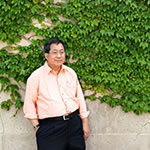
“If you can make a place that gives people an identity and let’s them know how, where, and when they are, and make it green, that will make architecture a success.” – Ken Yeang, T.R. Hamzah & Yeang
“I’m currently at my busiest, but I’m also at my happiest.” This is no small statement for any architect to make, especially one like Ken Yeang, who as the founding principal of T.R. Hamzah & Yeang has been working tirelessly at the forefront of green design for the past 40 years. We pushed him to dig a little deeper and talk about his state of content, and he shared with us his thoughts on green design and how to leave this world a happier place.
gb&d: You’ve been practicing green design for the past four decades. How did you break into the field during its early development, and why did you commit to its advancement at the start of your career?
Ken Yeang: In 1971, when I was finishing my undergraduate degree at the Architectural Association in London, green design wasn’t very fashionable. I went to go work on research at Cambridge on a Social Science Research Council grant—these are very big grants in the UK—and six months into the project, I realized it was all about the environment. But a record for that kind of work didn’t exist in architecture, so I enrolled in ecology courses in the Department of Environmental Biology. I earned my doctorate and published my dissertation, “Theoretical Framework for Incorporating Ecological Considerations in the Design and Planning of the Built Environment,” in 1975. This field of study was very important to me, and I went back to Malaysia and set up practice.
But the [architecture] field wasn’t ready to support it. There was no engineering support. I started by looking into passive mode design, which is similar to what I call “bioclimatic design.” It’s a climate-responsive approach; the design responds passively to the latitude and the climate of each project’s location.
gb&d: How long did it take for architecture to catch on to sustainable design?
Yeang: A little more than 15 years ago, the whole world jumped up and said, “We have to do something about the devastation of the environment!” Engineers started to support it. By 2010, every architect was doing green design.
This is a good and bad thing. Good because it’s good for the environment. Bad because it’s often not done properly. Even LEED can be misleading. It’s good because it creates greater awareness of green design, especially for clients, but bad because it’s disproportionate. It gives points for things like bicycle parking. A LEED Platinum rating is not an end-all. The Living Building Challenge pushes beyond LEED. It’s a step in the right direction because it’s performance-based.

In Singapore, Ken Yeang’s Solaris Tower integrates full-size trees and other plants into the façade, assisting in the research facility’s 36% reduction in energy consumption.

View from one of Solaris Tower’s many terraces.

gb&d: Sustainable design goes by many different names. Do you believe there is a right term?
Yeang: The term “sustainable” as it applies to architecture came from “Our Common Future,” a UN report. All the sustainability terms are synonymous. I like to think of it as shades of green, from light green to dark green.
gb&d: Where is your current design work taking you? Do you spend your days leading your offices, or do you still do research?
Yeang: We have three offices: about 30 people in London, 70 in Malaysia, and 300 in China, but they run independently. Right now, I have my office divided into six or seven teams, and I talk to each of them for about 20 minutes per day. We talk about their work, the day-to-day developments with clients, and how to manage their expectations. The meetings are back-to-back, and, when things are going badly or it’s very, very busy, it can be extremely depressing. But we also have a research topic of the day, and we often collaborate with consultants and universities to explore new topics. We push as far as we can. I spend my time researching and writing.
I’m also working on the aesthetic for green design. What should it look like? It’s a movement—just like Modernism—and it should have a whole new style. It should be hairy. It’s not pristine.

The nearly 16,000-square-foot living wall on the façade of this data center aids the building’s energy performance and provides added biodiversity and habitat to the site.


gb&d: Where do you want to push the field next? What’s the most important achievement architects must accomplish?
Yeang: There’s a whole generation of green designers being trained right now, and they’ll come into the field within the next three to five years, so green design will happen automatically. This is good. We’ll be able to focus on making architecture that makes people happy. If you can make a place that gives people an identity and let’s them know how, where, and when they are, and make it green, that will make architecture a success. My father told me that to be a good human being, you must do good, be good, and feel good. I’m trying to achieve that to varying degrees of success every day.

